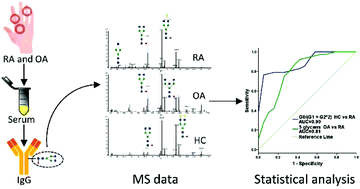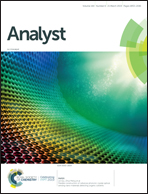Distribution of abnormal IgG glycosylation patterns from rheumatoid arthritis and osteoarthritis patients by MALDI-TOF-MSn†
Abstract
Glycosylation is a post-translational modification essential for maintaining the structure and function of proteins. Abnormal N-glycan patterns have been found in various diseases compared to healthy controls. A decrease in terminal galactosylated N-glycans of serum IgG in rheumatoid arthritis (RA) and osteoarthritis (OA) may be involved in their immunopathogenesis. However, how glycan patterns differ between RA and OA remains unclear. Here, we identified 15 glycan forms of serum IgG from RA and OA using MALDI-TOF MS. We found that IgG galactosylation represented a suitable candidate for differentiating RA from healthy controls (AUC > 0.9). Then, we performed binary logistic regression to screen out three bisecting N-acetylglucosamine (GlcNAc) glycoforms for distinguishing between OA and RA. Combined ROC analysis of the selected glycans yielded an AUC of 0.81 between OA and RA and an AUC of 0.79 between OA and RF/ACPA negative RA. Similar results were found in the validation set. In conclusion, our analysis demonstrates that RA and OA are distinguished on the basis of their different IgG glycan patterns, which thus serve as suitable candidates as biomarkers for reliably identifying clinical conditions such as RA and OA.



 Please wait while we load your content...
Please wait while we load your content...